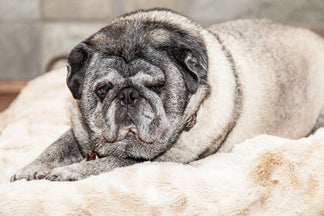So far in our Petnet Exercise Tips series, we have covered, Exercise Tips for Your Cat and Exercise Tips for Your Large Dog . Today we are going to offer a look at exercises for your small dog.
We defined large dogs as being over 40lbs, so let’s define our small group as dogs weighing under 20 lbs. Exercise for your little Chihuahua or Pug should be quite different than for a big Labrador or German Shepherd. Smaller, companion dogs don’t make good long distance running partners, nor are they usually well suited for herding, dock diving or other sports the bigger dogs excel at.
But these little lap warmers aren’t necessarily powder puffs and can be tough as nails. They may prefer being pampered, but they still need both physical and mental exercise. The amount and intensity of the exercise can be shorter and more relaxed, but you still want it to be fun and interesting for your pet.
A few ideas of exercises for your small dog:
- Walking is obviously a staple for any size or age of dog. Smaller dogs have shorter legs, so they may not go as far or as fast, but a good 20-30 minute walk once or twice a day will help keep them limber and fit. If you want to run with your smaller dog, keep the mileage down to a mile or less and keep a close watch on how they look to make sure they aren’t getting overly fatigued.
- Obstacle course runs are easy to create in your house for your little dynamo. You can easily have a mini-agility course with jumps over boxes or a hula hoop and tunnels made from cushions.
- Mental games are just as important for small dogs as for larger pups. We all need mental stimulation. You can accomplish this with treat games, hide and seek or obedience training.
- Hide and seek is a great indoor game to play with your pup you can even play it with little food treats and turn it into a “Find the Food” game.
- Don’t hold to the mistaken belief that all small dogs are content to have a light level of exercise. Their breed is more of a factor then their size when determining the proper exercise routines. Terriers, for example, need tons of exercise, even though they are considered a smaller breed.
A good measure of whether your dog is getting enough exercise is their demeanor and behavior. If a dog becomes destructive, tearing up the house or their toys or barking uncontrollably that might be an indication they are bored and need to get out and expend some energy. Likewise, if they are restless and constantly demanding attention, it may be a sign they need a mental challenge.
You also need to be aware of smaller dog’s physical limitations. Be cautious in the heat or if your dog is a brachycephalic breed (Pug), breathing may be harder for them, so shorter exercise jaunts are necessary. Some smaller dogs have shorter legs like the Dachshund or Corgi and may need a slower pace.
It’s also important to always check in with your vet when you start a new exercise routine with your pet. It’s important that they weigh in on any physical limitations they may have in order to keep your little guy safe.
Sources:
https://pets.webmd.com/dogs/guide/exercise-dogs
http://3lostdogs.com/9-ways-to-exercise-your-dog-without-walking-him/
http://www.vetstreet.com/dr-marty-becker/match-your-dogs-breed-type-to-the-right-exercise?page=2




 Health and Fitness
Health and Fitness
 Health and Fitness
Health and Fitness
 Health and Fitness
Health and Fitness
